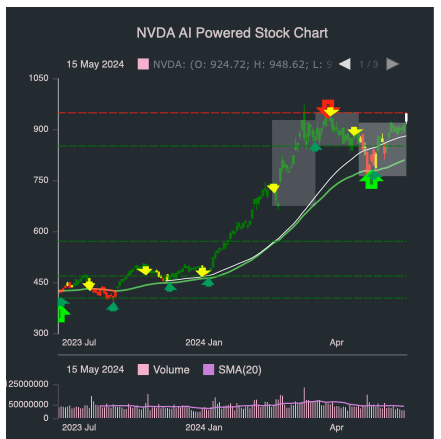20 Handy Facts On Choosing AI Stock Picker Platform Websites
20 Handy Facts On Choosing AI Stock Picker Platform Websites
Blog Article
Top 10 Tips On Assessing The Market Coverage Of Ai Stock Predicting/Analyzing Trading Platforms
When looking at AI trading platforms that forecast or analyze the market, coverage of the stock is an important factor to take into consideration. It determines which assets and markets are accessible. A platform with comprehensive market coverage will allow you to diversify your portfolio, explore new opportunities around the world, and adjust to various trading strategies. These are the 10 best strategies for evaluating the market coverage offered by these platforms.
1. Evaluate Supported Asset Classes
Stocks - Ensure that the platform can include the major stock markets (e.g. NYSE NASDAQ LSE HKEX) as well as includes mid-caps, small-caps and large-caps.
ETFs: Make sure the platform can support a broad selection of ETFs to provide a diverse exposure to sectors, regions or themes.
Options and futures. Find out if your platform offers derivatives such as futures, options or other instruments leveraged.
Commodities and Forex: Find out whether the platform is compatible with forex pairs, precious-metals, agricultural products, energy commodities, and other commodities.
Cryptocurrencies: Check to see if your platform supports the major cryptocurrencies like Bitcoin, Ethereum and altcoins.
2. Verify coverage in your area
Global markets. Ensure your platform covers the largest market in the world, such as North America Europe Asia-Pacific and emerging countries.
Focus on regional markets: Find out if a platform focuses on certain markets or regions which are in line to your business goals.
Local exchanges - Check to see if there are local or regional exchanges which are relevant to your area and your strategy.
3. Comparing Real-Time Data to Delayed Data Data that is delayed
Real-time data: Ensure that the platform has real-time data for trading and also for making quick decisions.
Delayed data - Check whether delayed data is free or is available at a reduced price. This might be enough for investors looking to invest in the long run.
Data latency: See whether the platform is able to reduce data latency, specifically for high-frequency trading.
4. Evaluate Historical Data Availability
Historical data depth Make sure the platform provides vast historical data (e.g., 10+ years) to backtest and analyze.
Granularity: Check if historical data includes daily, intraday, weekly, and monthly the granularity.
Corporate actions - Verify previous data to confirm that it includes stock splits or dividends as well as other corporate actions.
5. Review for market depth and order information
For a better price discovery experience Make sure the platform is equipped with Level 2 information.
Find out if there is a real-time bidding system and asking spreads. This will ensure that pricing is accurate.
Volume data - Check if the platform has detailed volume information for analyzing market activities and liquidity.
6. Examine Coverage to determine Indices and Sectors
Major indices: Check that the platform supports major indexes (e.g., S&P 500, NASDAQ 100, FTSE 100) for benchmarking and index-based strategies.
Information for specific industries If you're looking to do a more targeted analysis, check if there is data available for specific industries.
Custom indices. Determine if your platform permits you to create and track custom indexes based on the criteria you specify.
7. Test the combination of Sentiment and News Data
News feeds - Ensure that the platform integrates live news feeds with market-moving news from trusted (e.g. Bloomberg or Reuters) sources.
Sentiment Analysis: Find out whether the platform has sentiment analysis tools that are based on news, social media, or other sources of data.
Strategies based on events (e.g. economic announcements, earnings announcements): Check if your platform allows trading strategies based on events.
8. Make sure you have Multi-Market Capabilities for Trading
Cross-market Trading: Check that the system allows traders to trade across a variety of market segments and asset classes using a unified interface.
Currency conversion: Find out if your platform allows multi-currency trading and automated currency conversion.
Support for time zones: Find out if the platform accommodates trading in different time zones for global markets.
9. Evaluate the coverage of other data Sources
Alternative data: To gain unique insights, confirm whether your platform is using other data sources (e.g. satellite imagery, web traffic or credit card transactions).
ESG data: Determine whether the platform contains environmental social, governance, and (ESG) information to support socially responsible investing.
Macroeconomic data: Make sure that the platform contains macroeconomic information (e.g. inflation, GDP) for fundamental analysis.
Review Market Reputation and User Recommendations
User feedback is a fantastic method to assess the market coverage of a platform.
Find out about the platform's industry reputation. This includes awards and acknowledgement from experts in the industry.
Case studies: Search for case studies, testimonials, and other details that highlight the platform's effectiveness on specific assets or markets.
Bonus Tips
Trial period: Try out the platform for free to determine if it covers markets and what data is available.
API access: Check if your platform's API can access market data in a programmatic manner to conduct custom analysis.
Support for customers: Ensure whether the platform offers support for any queries relating to markets or data.
Use these guidelines to assess the market coverage offered by AI stock trading platforms. Choose a platform with access to the markets, information and tools you need to make trading successful. Market coverage is important to diversify portfolios, discover new opportunities and to adapt to changing market conditions. Read the most popular market ai info for website advice including stock ai, ai chart analysis, ai investment app, investment ai, ai stocks, ai investment app, best ai for trading, ai investing, ai investing, ai stock and more.
Top 10 Tips To Assess The Maintenance And Updates Of Ai Stock Trading Platforms
The maintenance and updates of AI trading and stock prediction platforms are crucial to ensure that they remain effective, safe and in line with the changing market conditions. These are the top 10 tips for evaluating update and maintenance procedures:
1. Updates Frequency
See the frequency of updates (e.g. every week, every month or every quarter).
The reason: Regular updates are evidence of a growing business, and a responsiveness to changes in the market.
2. Transparency is the key to the Release Notes
Review the notes in the Release Notes for the platform to discover what improvements and changes have been implemented.
The transparent release notes demonstrate that the platform is dedicated to ongoing improvement.
3. AI Model Retraining Schedule
You can ask the AI model how often it's retrained.
Why: As markets change, models need to adapt in order to remain accurate and relevant.
4. Bug Fixes, Issue Resolution
Tips: Check how fast the platform can address bugs or technical issues reported by users.
Why bugs are fixed in the shortest time possible in order to make sure that the platform is robust and efficient.
5. Updates on Security
TIP: Make sure that the platform frequently updates its security protocols to protect the privacy of traders and data.
Cybersecurity is crucial in financial platforms for preventing fraudulent activities and breaches.
6. Integration of New Features
Tip: Check whether the platform is introducing new functions (e.g. advanced analytics, new data sources) based on user feedback or market trends.
The reason: Feature updates show the ability to innovate and respond to user needs.
7. Backward compatibility
Check to ensure that the updates won't affect existing functionality, or require significant reconfiguration.
Why is that? Backward compatibility is important to ensure smooth user interface transitions.
8. Communication between Maintenance and User Personnel
You can assess the dissemination of maintenance schedules or downtimes to users.
Why: Clear communication reduces disruptions and builds confidence.
9. Performance Monitoring and Optimization
Tips - Make sure that the platform is constantly monitoring metrics of performance (e.g. latency, accuracy) and then optimizes the system.
The reason: Continuous optimization is essential to ensure that the platform remains efficient.
10. Compliance with changes to the regulatory framework
Find out if the platform updated its features and policies in order to be compliant with any new privacy laws or financial regulations.
Reasons: Regulatory compliance is crucial to reduce legal risks and maintain confidence in the user.
Bonus Tip - User Feedback Integration
Verify that the platform taking feedback from users into updates and maintenance. This shows a user-centric attitude and resolute determination to make enhancements.
By evaluating these factors by evaluating these factors, you can ensure that the AI-powered stock prediction system and trading platforms that you select are regularly maintained, updated, and able to adapt to the changing dynamics of markets. Take a look at the recommended this post for website examples including best ai trading platform, ai software stocks, ai for trading stocks, stock predictor, ai copyright signals, ai options trading, invest ai, ai share trading, ai stock trader, ai stock predictions and more.